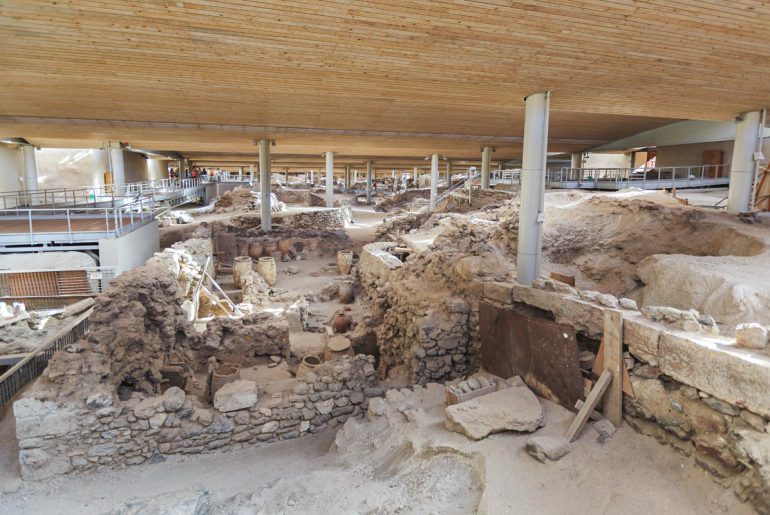Seven thousand years ago the Santorini as travelers know it today was a vastly different human habitat. What must have begun as a collection of Stone Age fishing and farming villages, soon became a trading center between Minoan Crete and Cyprus sometime after 3000 BC.
Scholars think that ancient Santorini became significant because of its strategic location first, and later because of critical trading with goods like copper. For these and other reasons, Santorini and its most famous ancient settlement of Akrotiri must have been a shining example of culture and civilization. Today visitors can still see remnants of paved streets, a cutting edge (for the time) drainage system, multistoried buildings, and artifacts of indescribable beauty and innovation. As part of the Minoan Civilization, Akrotiri and ancient Santorini flourished for more than 500 years, until the catastrophic eruption of Thera sometime between 1642–1540 BC.
Archaeologists estimate the first settlements on the island date back to the Post Neolithic Period. Akrotiri today is a kind of time capsule, not so different from the Roman city of Pompei, where the volcanic matter that covered the city and the whole island ended up protecting and preserving the buildings. Some historians contend that Santorini was the inspiration for Plato’s story of Atlantis, as mentioned in his dialogues Timaeus and Critias.
When visiting the island, travelers should be aware there are actually two settlement sites from ancient antiquity. Akrotiri is the oldest known settlement, but Ancient Thera (Αρχαία Θήρα) on top of Messavouno dates to the time of the Spartan settlers who came to the island during the 8th century BC. It is from this high dwelling place that Santorini tourists will capture the most stunning views anywhere on the island.
We also recommend visiting Fira, where you will find several museums that are worth seeing. First, the Prehistoric Museum holds many exhibits from Akrotiri and other archaeological sites on Santorini. There’s also the Archaeological Museum, that presents findings and artifacts from Ancient Thera. Also, a must-see is the Gyzi Megaron and the Museum of Local History, situated in the Kontochori Quarter.
Finally, there is indeed something magical about Santorini, and something more than the visual of a vanishing sun in the West. Certainly, the dramatic landscape of jagged hills plunging into the blue Aegean is stunning, and the picturesque whitewashed houses with blue roofs create a living postcard for visitors. Great people and remarkable cuisine make the island special too. However, one cannot help but sense there is something more here. Something magnetic that compelled those adventurous settlers to make the journey into what would become the new world.
Maybe an ancient Greek myth serves to explain the island’s distinctive character. According to old Greek stories, Santorini was formed out of a miracle connected to the famous Argonaut expedition. According to the legend, Jason and his shipmates were on their way home, when they landed on Anaphe, a small island of the Aegean Sea.
It was here that Euphemus had a vision of making love to a nymph, a siren who was the daughter of the messenger of sea god Triton. After their union, the woman told him she had become pregnant with his child and chided him over how her father would be angered. She begged for a place to hide so that she might escape the wrath of the god, to which Euphemus responded by throwing a clod of dirt into the sea. This speck miraculously re-emerged from the vacant sea and turned into an island. Euphemus named it Calliste, which means the most beautiful, but the name “Thera” is from his son of the same name, who was born there. And so, it seems clear that Santorini has been beloved by the gods from the dawn of times.




